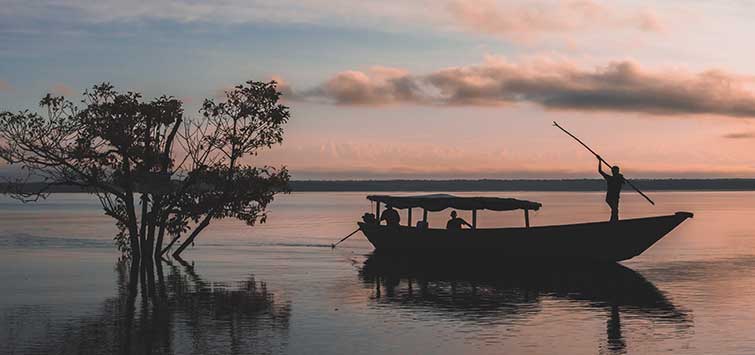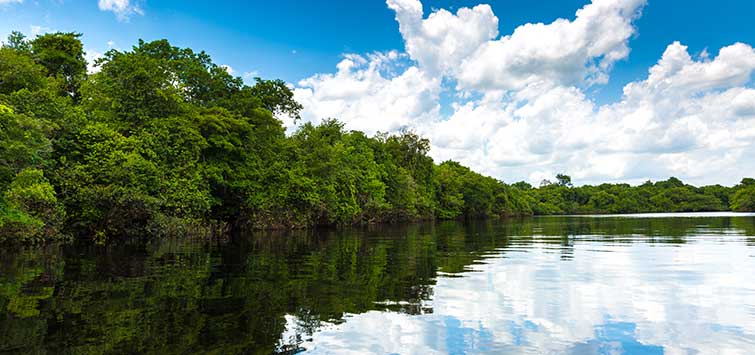Diving into the Rio Negro: Fishkeeping Lessons from the Amazon
Mark Chen with Fernando Lessa
South American fish species hold a special place in my heart. I don’t know if it’s the association with the mysterious Amazonia, or just their colors and looks. I’ve found myself, like many others, drawn to them in a profound way. That’s why when the chance to explore the enigmatic Rio Negro presented itself, I knew I had to do whatever it took to make it happen.
Although Brazil seemed a world away, convincingly presenting a trip to the Rio Negro as a “business opportunity” to my wife presented more of a challenge than the actual distance. Since I had already gone on an expedition to the Rio Inírida in Colombia in 2019, I could no longer use the “It’s a once in a lifetime trip!” pitch. However, either by the charm of my dad bod or the miracle of love itself, my wife gifted this trip to me as the best birthday present any aquarist could ask for.
Our trip started in Manaus, and then we boarded a small plane to Barcelos, which is the oldest town in the state of Amazonas. The historical town was once a hub of rubber extraction; it’s now a small place for fishing enthusiasts to stay and try to catch the biggest peacock bass they can. We were to travel on a double-decker boat with a slightly smaller supply vessel accompanying us for our week-long exploration.
Heading Out onto the Rio Negro
Off we went into the vastness of the Rio Negro. Our boat was pretty sizable, considering that my previous trip featured just one steel “speed” boat that sat eight people, max. This time we even had rooms with bunk beds that slept 15 to 20 people in relative comfort. However, it was also because of the size of the boat that we weren’t able to penetrate the rainforest to our intended depth due to the severe drought that much of the Amazon basin was experiencing.
The water level had gotten so low that river access for our boat was extremely limited. It’s hard to tell just by looking at the river—it’s still an immense body of water that seems to stretch to no end. The Rio Negro is, like its name suggests, a blackwater river. You’d think there’s not enough tannin in the whole world to color a river with this much water, yet all of it flows like black tea.
When you are even slightly outside civilization as we know it, things tend to not go according to plan. We were stranded even before we set off due to an engine failure, so we were forced to spend some relaxing time by the beach, where some of the indigenous people live in houses sitting on stilts. By the height of the stilts, we could see just how low the water really was at that point, and how high it can rise in the rainy season—as much as 20 feet (about 6 meters).
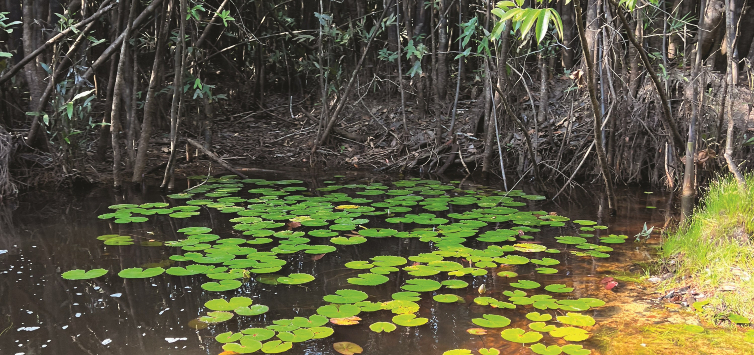
Enjoying TFH Magazine? Subscribe Today!
A River Dolphin Encounter
As we finally set off to our first destination, the mouth of a small tributary that has clearer water, I was immediately drawn by the trees and their twisty roots all along the riverbanks. It’s not hard to imagine all the fish living in and around the safety of those roots. On the way to our first destination, we were pleasantly greeted by some tucuxi dolphins. They were dark gray and much smaller than the pink dolphins we had the chance to get up close and personal with in Manaus.The resident pink dolphins around Manaus have become a local economic engine, one of the must-sees for all tourists. The locals set up float stations on the river and call to them, who recognize their “dinner bell.”
The pod of 30 or so dolphins claim this part of the river and split into different groups to visit the several floats. They form a relationship with the people who work at each one. The float we visited had four or five dolphins playing and begging for fish around us after the “trainer” called for them. The “trainer” repeatedly slapped a long piece of wood board on the water surface, and, soon after, his group of dolphins showed up right on cue.
It’s easy to tell the trust between the dolphins and the “trainers” and the unique bond they have formed. Each dolphin has a name, and some are more easily recognizable than others because of a unique marking or injury. But, clearly, the trainers recognize them all. I had mixed feelings about this; however, it’s a much better outcome for the dolphins when people prize them not for their flesh but for the economic value of them staying alive and healthy.
Into the Shallows
As we arrived at the wide mouth of the tributary, the water became very shallow, with only about a foot depth in some areas. With still a tinge of yellowish brown, the water was very clear here. We could see some fairly large fish darting by, a species of Crenicichla, known as pike cichlids. It was a surprise to see large pikes swimming in such a shallow area. I suppose that was one of their hunting grounds. I also spotted the first of many stingrays on this trip. The locals call them cururu, which I found so fun to say that it became something we constantly just shouted out for no reason.
With much excitement, we slowed the boat to a stop and went down by the beach. Immediately, everyone took out their goggles and got into the water. All around us, we were greeted by small tetras, pencilfish, and sub-adult Dicrossus filamentosus, checkerboard cichlids pecking on the superfine sandy substrate.
I didn’t expect checkerboard cichlids to be one of the most commonly seen fish in the water, but they were at every turn, all sub-adults. I found that to be weird and a little disappointing. I had been hoping to see the beautiful adult fish that display their long streamers, but I did not see a single one throughout the trip.
Only a few minutes passed before I was called by Gabor, one of my fellow explorers. “Come here, there are a lot of cardinals!” he shouted with glee in his British accent. I immediately swam over and, sure enough, sub-adult cardinals in all of their glorious red and iridescent blue were swimming in the shallows near the roots of plants and trees.
Their color is so striking in the tea-colored water that it makes me wonder about something I’ve never given much thought to: How would that be an advantageous evolutionary trade-off, being so clearly spotted by any predator? Yet the ubiquity of this species in the shallows of the Rio Negro and its tributaries suggests its success. We saw them so often that it became no different than seeing them in my own tank.
There were many species of micro-fish all inhabiting the shallow water in perfect harmony. Those we usually assume to have a bit of an attitude, like apistos, lived in the leaf litter in very close proximity with the checkerboards, pencilfish, and whatever else was coming and going. I can’t be confident in my ID, but I think I saw a few Apistogramma agassizii. Again, these guys were sub-adults—as with the checkerboards, I did not see even one adult apisto on the trip.
Besides the cardinals, the sight of one particular fish made me very happy: rummynose tetras! Unlike their common aquarium behavior, swimming in schools, they don’t swim tightly grouped in the wild. I don’t know if there were just not enough of them, or if my presence disturbed them, but they were clearly swimming as individuals rather than as a shoal or school.
It could be the fact that there are very few predators around that part of the shallows, so they didn’t feel the need to stay within the protection of a school. Also, as you can begin to see a pattern here, no adult-sized specimen was seen. Why is that?
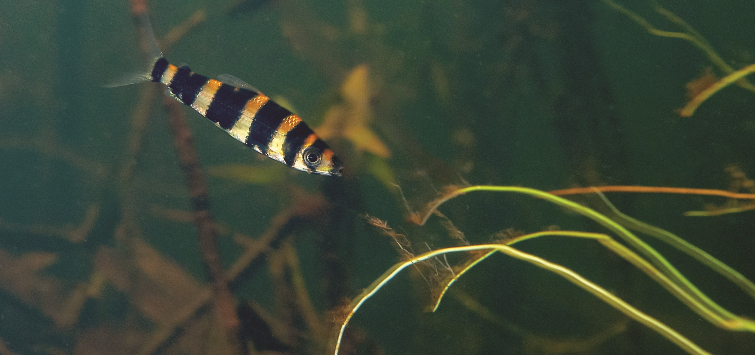
Swimming in Deeper Waters
We made it up the winding stream where the flow of the water became visibly faster and much deeper. The change in depth along the bottom was dramatic, with parts of it being only a meter deep, dropping off to more than 3 meters deep within just a short distance.Larger fish inhabit this part of the water. We first found some catfish swimming under a log. A beautiful striped Raphael cat caught our eyes. It was trying to wedge itself inside the hole in the log but decided that its body was still too exposed, so it turned around and bailed. I tried to chase it, but it was already gone.
Swimming down a little farther, I saw a small school of leporinus—they were huge! The torpedo-shaped body makes them extremely fast travelers. I only got a glimpse of them before they were gone. I eagerly followed them in the direction they were going, and suddenly the stream became much deeper.
Multiple fallen trees and branches swayed with the current, and it apparently made a nice home for multiple species of large fish. I swam to the top of a spot where all the large predators were hanging around. Luckily, there was a big branch near the water surface, so I held onto it and looked down.
There was a cururu lying on the bottom, not minding what was possibly a pair of pike cichlids swimming in circles near it. The pikes weren’t there to bother the stingray, nor did they seem to take an interest in it. They were just simply hanging out, like they were sitting on the couch at home.
There were at least two species of large leporinus swimming in schools around this spot, which seemed to be home to all these fish. Then there was a rather large school of cichlids swimming around the sunken trees. They were large adults, I estimated them to be at least around 8 inches (20 cm).
The Grassy Shallows
In the shallower part of the stream, fallen trees, branches, and roots formed perfect homes for various fish. I saw different species of adult-sized severums, festivums, and chocolate cichlids, and different species of pike cichlids. I even filmed a big festivum mouth-wrestling with a smaller severum; even the best of neighbors have quarrels sometimes.
One thing that is not hard to notice in the Rio Negro and its tributaries is that it is completely devoid of rocks. The entire river just doesn’t seem to have any. As odd as it might sound, the elements in the water consist of only wood, fine sand, and plants. There is wood—so, so much wood, in every shape and arrangement—but not a rock to be found.
One particularly beautiful aquatic scene was the huge patches of very thin, long plants swaying with the strong current growing on the sand mounds at the turns of the stream. The wavy motion was so mesmerizing, and some patches get so large that they seem to stretch on endlessly.
These patches were a trippy visual experience, which I found to be disorientating when snorkeling very close to them. I can’t stop wondering how I would be able to replicate that in an aquarium: How does one even stop the sand from blowing everywhere with that much current?
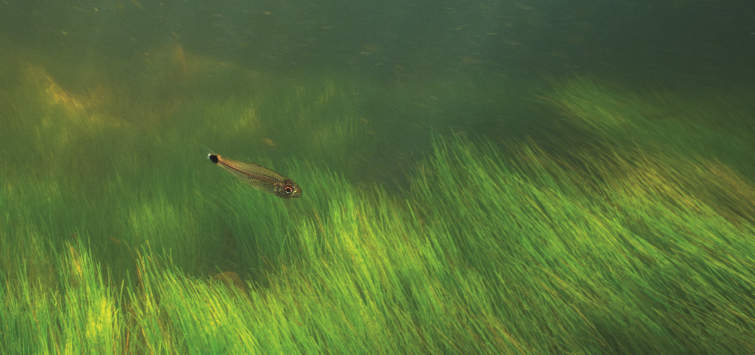
Lessons from Nature
When thinking about aquascaping, we often concentrate on what’s within the water and focus on composition below the surface. However, in nature, everything is connected, above and below the waterline. Extensive tree structures reach their complex roots into the river along the bank, their branches break and fall in the water to become driftwood, plants grow along the sandy riverbank and down into the rushing currents, and fish of all descriptions make their home among all of it.Exploring the Rio Negro and its tributaries was an illuminating and magical experience. If you ever get the chance to explore any natural habitat, seize the opportunity. Whether in the depths of the Amazon rainforest, or just a local stream near you, these wild places and their native inhabitants are worth exploring. This is especially so because so many of them, like the magical habitats of these Rio Negro tributaries, are quietly disappearing.

.png?h=595&iar=0&w=2781&hash=5FD5E69473BCC22199FBFA2FB71B6033)


